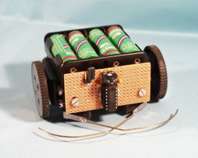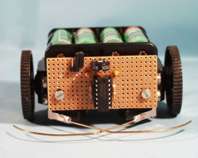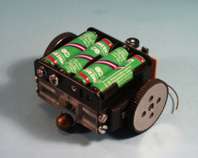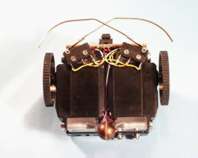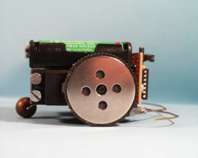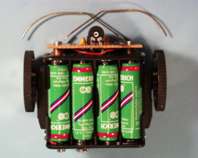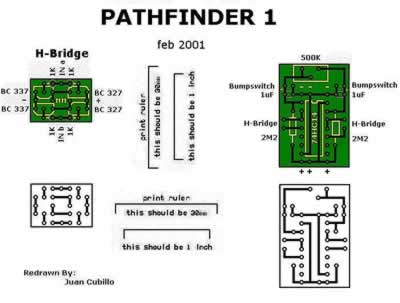|
INFO about
Pathfinder
|
|
Pathfinder 1 is a small bot, easy to build with cheap
components.
It is powered with four penlites. I've used 1300 mAh, giving power for
more then 5 hours to this bot ! When "starting up" this bot it reverses,
and then goes of in a random direction. When bumping with the left feeler,
it instantly changes direction and also reverses for some distance. After
that it goes forward again. When bumping with the right feeler occurs, it
does the same but then it turns in the other direction.
While playing with this bot I also saw that the angle of change in
direction depends on how "hard" it hits an obstacle. When it bumps almost
from the front, the change is somewhere near 30 to 40 degrees, but when it
"just hits" an obstacle the change can be as much as 180
degrees. |
| FUN
FUN FUN FUN FUN FUN |
|
When it is "playing" in my Jurassic park, I like to put in some small
balls. Within a few minutes the balls are all moved into the corners of
the JP. Thanks to the construction of this bot, those are the favorite
places where it gets. Sometimes it even "kicks" a ball away with its
feelers. I believe that it could grow into a new kind of sport:
Building a bot as simple as possible with the task to move a number
of balls into the corners. The bot that does it in the shortest time is
the winner. No computer allowed.
By the way, the balls I took out of old DEO rollers. There are several
sizes, the biggest balls are better. |
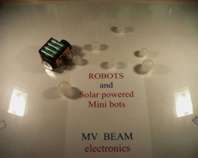 |
|
Just imagine when there are a
few of these bots....
you could play SOCCER
! |
| How it works.... |
|
This is the "normal" way to make a bot go reverse. Nothing new, and I'm
sure that a lot of people recognize it.
The time of reverse can be changed with the R and C. Bigger R means
more reverse time and a bigger C also etc.
Using two of these "reverse timers" and two feelers make a bot change
direction and hopefully avoid obstacles. |
|
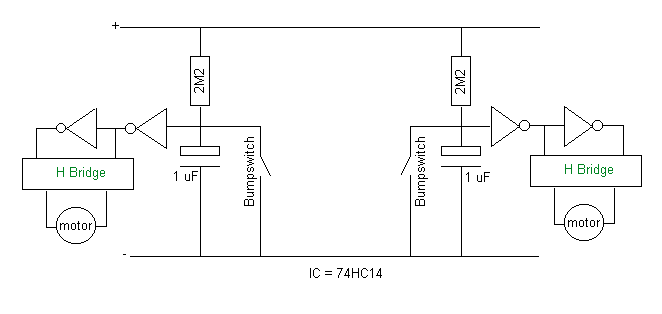
|
|
Just by changing the connection of the switches and putting in a
adjustable resistor (500 Kohm) , this bot will turn and go reverse when
bumping with one of the two switches.
When going forward, both bump switches are in the "NC" position. The
500K resistor has no function or influence.
Suppose the left switch has gone to the "ON" position thanks to a bump,
the right capacitor is discharged instantly, the right output changes and
the motor reverses. The left capacitor is discharged by the 500K resistor,
and the left output changes a little time later so that motor will reverse
also. Thanks to the difference in "reaction time" the bot is going reverse
in a different direction as where it came from.
Because of going reverse, the triggered bumpswitch "falls back" into
the "NC" position, the 500K resistor again has no influence, and both
capacitors are charged. The voltage will be equal, causing the both
outputs to change at the same time, so the bot will go forward again.
When bumping with the right switch, the same will happen, but then
"like in a mirror". |
|
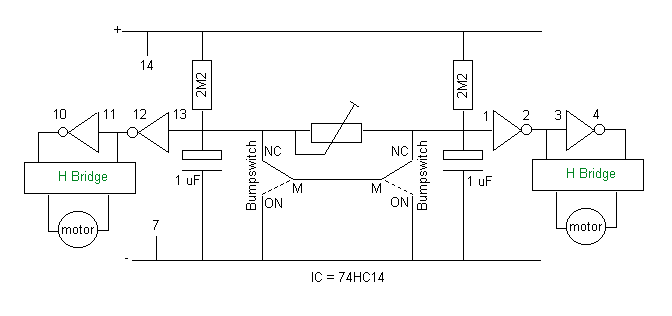
|
| Pathfinder
schematic. Simple, isn't it ? |
|
With the variable resistor the changing angle can be adjusted. When the
value is to big, it can happen that only one motor reverses. Especially
when the bot is fast and the bumpswitches are "triggered" to short.
|
|
To make visible what is happening, you could use a indication like
this:
Connect it to one of the outputs going to the H bridge. I've used pin
12 and 2. |
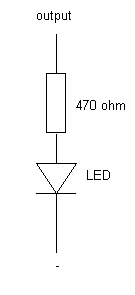 |
|
Wheels !
The wheels are made from some metal pieces. I have a box full of them
and got them a few years ago. Don't know where I got them, but they make
perfect wheels for servo's. The toothed belt is from an old printer, a
very old one. It had two belts, each long enough to make 7 wheels. I just
glued it on the metal "things" .
Didn't I mention it before ? The Pathfinder is driven with two servos,
bought last year on a exhibition for only 2 dollars each (new ones,
without electronics !). The gears are made from brass. Just bought 4 of
them. Pity ! |
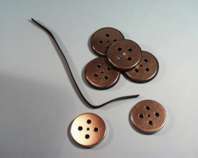 |
|
H Bridges
I made new H bridges for this bot. You'll need two of them. They can be
made very small on uni board. In the picture you see the blue C in the
middle of the board, it's a 22 nF capacitor. It can also be placed on the
motor directly. |
|
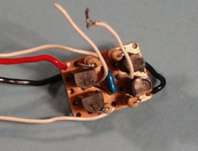
|
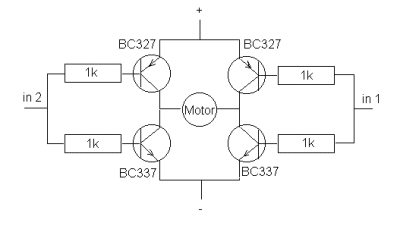 |
|
Just some Tips
Leave some space between the two servo to put all the cables. Looks
nicer!
The third support (at the back) is made from a small bead. Look at the
pictures. I've used a big paper clip for making the axle. In the pictures
you can see how it needs to be bent. |
